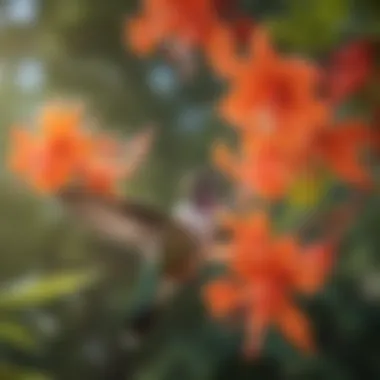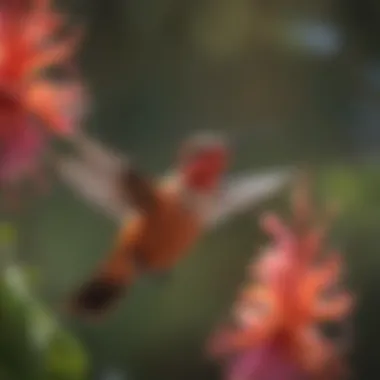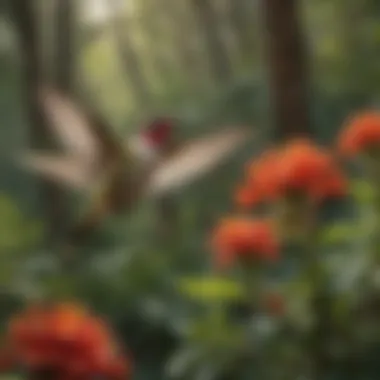Discovering Hummingbird Flowers in Southern California


Intro
Hummingbirds are a remarkable group of birds known for their incredible agility and vibrant colors. In Southern California, these dynamic creatures find a haven in the diverse floral landscapes that bloom throughout the region. Understanding the specific flowers that attract hummingbirds is essential for anyone interested in promoting biodiversity and fostering an enriching environment. This section delves into the correlation between hummingbirds and flowering plants, setting the stage for a deeper exploration of their interplay.
Overview of Hummingbird Preferences
Characteristics of Hummingbird-Attractive Flowers
Hummingbirds are particularly drawn to flowers that exhibit certain characteristics. These include:
- Vibrant colors: Bright reds, oranges, and pinks are especially appealing.
- Nectar production: Flowers that produce generous amounts of nectar are more likely to attract these birds.
- Tubular shapes: Many hummingbirds prefer flowers with tubular shapes, which make nectar more accessible.
Understanding these preferences can serve as a guide for gardeners and landowners eager to create a thriving environment for hummingbirds.
Native Flowers in Southern California
Several native flowers thrive in the Southern Californian climate and serve as excellent sources of nectar for hummingbirds. Some notable examples include:
- California Fuchsia (Epilobium canum): This perennial has bright red flowers and blooms in late summer through fall, providing late-season nourishment for hummingbirds.
- Penstemon: With numerous species, penstemons feature tubular blooms that hummingbirds seek out.
- Salvias: This group includes various species that offer not just visual appeal but also nectar-rich flowers.
Planting these native species encourages an ecosystem where hummingbirds can flourish.
Importance of Nectar Flowers in Biodiversity
"Nectar-producing flowers are not just attractive to hummingbirds; they are fundamental to the pollination process and support wider ecological diversity."
The presence of nectar flowers supports not only hummingbirds but also a range of other pollinators. When planning gardens or landscapes, integrating these flowering plants fosters a holistic environment. Such practices contribute to the maintenance of healthy ecosystems, making it essential for landowners and professionals to be aware of the floral needs of hummingbirds.
Creating Hummingbird-Friendly Gardens
Creating a hummingbird-friendly garden requires careful selection of plants and consideration of habitat preferences. Here are important pointers:
- Choose native plants: Native species are adapted to local conditions and provide the best resources for local wildlife.
- Plant in clusters: Grouping flowers together increases visibility for hummingbirds, making it easier for them to access nectar.
- Maintain a garden calendar: Plan for staggered bloom times to ensure a consistent supply of flowers throughout the year.
Final Thoughts
The significance of hummingbirds in Southern California's ecosystem cannot be overstated. By understanding their floral preferences and fostering environments that promote biodiversity, residents and professionals alike can play a pivotal role in enhancing the region's ecological integrity. Next, we will delve into the ecological factors that influence these interactions and explore habitat preservation strategies.
Prologue to Hummingbirds
Hummingbirds are remarkable creatures, engaging in a fascinating relationship with the flora that surrounds them. Understanding the dynamics of this interaction is vital for a deeper appreciation of biodiversity, especially in ecosystems like those found in Southern California. Hummingbirds play a critical role in pollination and serve as indicators of environmental health due to their sensitivity to habitat changes. Furthermore, the flora that attracts them often includes native plants that support other wildlife, enhancing the ecological web.
Overview of Species
Southern California is home to several hummingbird species, each with unique characteristics and behaviors. Among the most noted are the Anna's Hummingbird, Allen's Hummingbird, and Rufous Hummingbird. The Anna's Hummingbird, for instance, remains in the region year-round. It exhibits vibrant iridescent feathers and a distinctive call. Conversely, Allen's Hummingbird primarily breeds along the coast and migrates to Mexico in winter. The Rufous Hummingbird is more migratory and travels vast distances, showcasing incredible endurance.
The diversity of species in Southern California underscores the necessity for specific flowers that cater to their feeding and nesting habits. Each species has distinct flower preferences based on color, shape, and nectar production. Awareness of these preferences is essential for anyone interested in creating a hummingbird-friendly environment.
Migration Patterns
Migration patterns of hummingbirds significantly affect their interactions with local flora. For instance, the migratory route of the Rufous Hummingbird typically runs along the Pacific Flyway, leading to its arrival in Southern California in spring. They seek out specific flowering plants for sustenance during their long journey.
Understanding these patterns allows landowners and environmentalists to plant appropriate species at the right time. This planning ensures that there is a reliable food source for migratory birds when they arrive. Hummingbirds also exhibit incredible navigation skills. Research shows they can use the position of the sun and Earth's magnetic field to guide their paths, relying on well-timed blooming patterns of native flowers.


"Hummingbirds are not merely beautiful; they are critical pollinators that support our ecosystems and highlight the importance of preserving native flora."
In summary, recognizing the dynamics of hummingbird migration and species diversity in Southern California is key for fostering environments that support these essential avian pollinators. By planting suitable flowers and understanding seasonal movements, we can contribute to a thriving ecosystem that benefits both hummingbirds and the broader biological community.
The Ecology of Hummingbirds
Understanding the ecology of hummingbirds is essential in appreciating their role within the Southern California ecosystem. Their presence not only signifies healthy habitats but also reflects the intricate relationships among various species. Hummingbirds, particularly the Anna's hummingbird and the Costa's hummingbird, thrive in environments rich in certain floral species. This interdependence highlights the importance of specific ecological elements that sustain them.
Feeding Behavior
Hummingbirds are known for their unique feeding behavior, primarily relying on nectar as their energy source. These birds possess specialized tongues that can extend to extract nectar from deep within flowers. They are particularly drawn to tubular flowers, which offer a reliable nectar source. In Southern California, species like the California fuchsia and hummingbird sage are prime examples of plants that attract these birds.
Hummingbirds feed frequently throughout the day, visiting numerous flowers to meet their high-energy demands. This feeding behavior is critical not only for the birds’ survival but also for the plants they visit. As hummingbirds move from flower to flower, they inadvertently facilitate pollination. By transferring pollen from one bloom to another, they contribute significantly to the reproductive success of many native species.
Role in Pollination
Pollination is a key ecological function that hummingbirds serve, and it is essential for plant reproduction. Many plants in Southern California have evolved specifically to attract hummingbirds. The birds are unique in their pollination strategies, as their rapid wing beats allow them to hover while feeding, enabling efficient access to nectar.
Research has indicated that hummingbirds are effective pollinators for certain species that other pollinators may overlook. For example, plants like the Buddleja or Butterfly Bush benefit from hummingbird visitation, which can lead to increased seed set and genetic diversity. This relationship between hummingbirds and native flora underscores the importance of conserving natural habitats.
"The role of hummingbirds in pollination is not merely beneficial; it is essential for the viability of many plant species in Southern California."
Incorporating hummingbird-friendly plants in gardening practices can significantly enhance local biodiversity. Gardeners who cultivate these plants often notice an increase not only in hummingbird population but also in other pollinators like bees and butterflies. This interconnectedness illustrates the broader implications of individual choices in gardening and landscape management.
To summarize, the ecology of hummingbirds is deeply intertwined with their feeding habits and their role as crucial pollinators. Understanding these dynamics fosters greater awareness of the need to preserve native habitats and encourage the growth of hummingbird-attracting flora. This not only benefits the birds themselves but also bolsters the resilience of local ecosystems.
Characteristics of Hummingbird Flowers
Understanding the characteristics of hummingbird flowers is crucial for anyone interested in promoting biodiversity and creating habitats for these unique birds. Hummingbirds are drawn to flowers that meet their specific needs for feeding and nesting. This section will explore two essential characteristics: color preferences and flower shape and structure.
Color Preferences
Hummingbirds exhibit distinct preferences for certain flower colors. They are most attracted to vibrant colors such as red, orange, and pink. These hues are not only visually striking but also signal to the birds that a flower is likely to offer nectar. The bright colors act as a beacon, making it easier for hummingbirds to locate their food sources.
Additionally, most hummingbirds rely on color to avoid flowers that do not offer food. For gardeners and ecologists, planting a variety of these colors can enhance the likelihood of attracting hummingbirds to a garden.
- Red and orange flowers tend to appeal most to these birds, as these colors signal food availability.
- Plants flowering in spring, summer, and early fall are critical, as these are the times when hummingbirds are most active.
- Including a diverse range of colors can create a dynamic and inviting environment for hummingbirds.
Flower Shape and Structure
The physical attributes of flowers also play a significant role in attracting hummingbirds. Specific shapes and structures allow for more efficient feeding behavior. Flowers with tubular shapes are particularly favored; they allow hummingbirds to easily insert their long bills and access the nectar inside. This anatomical compatibility is vital for both the birds and the flowers, facilitating a more effective pollination process.
- Tubular flowers, such as those produced by the California Fuchsia, are preferred as they match the hummingbird’s anatomy.
- Flat flowers may not be as accessible for feeding and, as a result, are less attractive to these birds.
- Certain flowers provide perches while others do not, which can influence a hummingbird's choice.
In summary, the characteristics of hummingbird flowers—color preferences and structural design—are integral to enhancing interactions between hummingbirds and their environments.
"Selecting the right flowers based on these traits can significantly impact the local ecosystem and contribute to greater biodiversity."
By recognizing these traits, gardeners can become strategic in their planting choices, aiding not just hummingbirds but other pollinators as well.
Native Hummingbird Flowers of Southern California
Native hummingbird flowers play a crucial role in the ecosystem of Southern California. These plants are specially adapted to thrive in the local climate, and they provide a source of nectar that is vital for the survival of hummingbirds. By cultivating these flowers, garden enthusiasts can support biodiversity, attract these remarkable birds, and create habitats that benefit multiple pollinator species.


Selecting native flowers for a hummingbird garden ensures that the plants can withstand local conditions, such as drought and fluctuating temperatures. Familiarity with the specific needs of the regional flora not only optimizes garden success but also contributes to the preservation of the unique ecology of Southern California. The relationship between native flowering plants and hummingbirds illustrates a larger synergy within the environment, emphasizing the need for conservation and responsible gardening practices.
California Fuchsia (Zauschneria californica)
California Fuchsia, or Zauschneria californica, is a perennial plant known for its bright red tubular flowers that bloom from late summer to early fall. This flower is particularly appealing to hummingbirds, as its color and shape are ideal for their feeding habits. The species thrives in various soil types, especially well-drained areas, and can withstand mild drought conditions, making it an excellent choice for gardens seeking to attract hummingbirds.
In addition, California Fuchsia is valuable for its ability to support other local wildlife and promote biodiversity. Its flowers provide nourishment not only to hummingbirds but also to other pollinators, such as bees and butterflies. This interconnectedness in the garden underscores the importance of planting indigenous species for ecological resilience.
Hummingbird Sage (Salvia spathacea)
Hummingbird Sage, or Salvia spathacea, is another essential native flower. Its soft pink to purple flowers are arranged in dense spikes, making it highly attractive. The flowering period generally occurs in spring and early summer, aligning well with the migratory patterns of hummingbirds in the region.
This plant prefers well-drained soils and partial shade but can also adapt to full sun. Hummingbird Sage also offers aromatic foliage, which adds an additional sensory aspect to the garden. By incorporating this sage into a hummingbird garden, gardeners can create an inviting haven that benefits both birds and broader ecological health.
Buddleja (Butterfly Bush)
Buddleja, commonly known as Butterfly Bush, is a remarkable flower favoured by both hummingbirds and other pollinators. It features long clusters of small, fragrant flowers that can vary in color from purple to white, attracting a wide range of wildlife. This shrub grows vigorously and can reach heights of ten feet if well cared for, making it a prominent feature in hummingbird gardens.
Despite its name, it is essential to choose the right cultivar, as some non-native species can become invasive. Gardeners should opt for native varieties to ensure that they do not disturb local ecosystems. Buddleja complements other native plants while providing essential nectar sources, thereby offering considerable ecological benefits.
The strategic planting of native flowering species like California Fuchsia, Hummingbird Sage, and Buddleja fosters a thriving environment for hummingbirds and strengthens ecological networks within the Southern Californian landscape.
Cultivation Techniques for Hummingbird Gardens
Cultivating a hummingbird garden requires attention to detail and a strong understanding of the environmental factors that support these birds. The techniques outlined here not only enhance the beauty of your garden but also significantly contribute to the well-being of hummingbirds. By selecting appropriate sites, managing water and nutrition, and controlling pests, any gardener can create an inviting habitat for these fascinating creatures.
Site Selection and Preparation
The selection of an optimal site is fundamental for attracting hummingbirds. Gardens should ideally be placed in areas with ample sunlight and protection from harsh winds. Hummingbirds are drawn to brightly colored flowers that provide nectar, but they also require resting places such as shrubs or trees nearby. Soil preparation is equally crucial. Well-drained, nutrient-rich soil is necessary for healthy plant growth. Adding organic matter, such as compost or well-rotted manure, can enhance soil quality.
- Considerations for site selection:
- Sunlight: Choose areas that receive at least six hours of sunlight daily.
- Shelter: Provide nearby sheltering plants to offer safe resting spots.
- Access: Easy access for maintenance and observation should be considered.
"A hummingbird garden not only serves as a sanctuary for birds but also enriches the local ecosystem."
Watering and Fertilization Strategies
Proper watering and fertilization techniques are pivotal for sustaining a hummingbird garden. Hummingbird-attracting plants are often native and require less water and fertilization compared to non-native species. Early morning watering is advisable, allowing soil to absorb moisture before the heat of the day.
- Watering tips:
- Water deeply but infrequently to encourage deep root growth.
- Mulch around plants to retain soil moisture and suppress weeds.
Fertilization should be approached cautiously. Many plants thrive on minimal intervention. However, using a slow-release fertilizer in early spring can provide necessary nutrients without overwhelming plants.
Pest Management Practices
Pest management is often overlooked but plays a key role in maintaining a hummingbird-friendly garden. Chemical pesticides can harm hummingbirds and other beneficial insects. Instead, an integrated pest management (IPM) approach is recommended. This includes monitoring for pests, encouraging natural predators, and using organic solutions when necessary.
- Effective pest management strategies:
- Hand-picking: Regularly check plants for pests like aphids, removing them manually.
- Beneficial insects: Attract ladybugs and lacewings to combat pests naturally.
- Neem oil: A natural pesticide that can control a variety of pests while being less harmful to wildlife.


Using these cultivation techniques lays the groundwork for a vibrant garden that supports both hummingbirds and the larger ecosystem. Each step focuses on understanding the needs of both plants and wildlife—creating a splendid environment that benefits all inhabitants.
Enhancing Biodiversity with Hummingbird Flowers
The relationship between hummingbirds and specific floral species extends beyond simple attraction. It serves as a vital key to enhancing overall biodiversity in Southern California. Hummingbirds are not just beautiful creatures. They play an essential role in the ecosystem by acting as pollinators for many native plants. This group of plants has evolved over millennia alongside these birds, resulting in a mutually beneficial relationship. When the right flowers are planted, this connection allows for greater opportunity for species coexistence.
To create a hummingbird-friendly garden is to simultaneously work towards supporting various forms of life. Utilizing native flowers designed to attract these birds contributes to the health of the ecosystem. This in turn can lead to improved soil quality, better water retention, and greater pest control. Enhancing biodiversity is not just advantageous for the species involved; it contributes to a stable environment. A biodiverse ecosystem can withstand disturbances better, offering resilience against opportunistic threats, such as invasive species.
Interconnected Ecosystems
Irrigated vs. Dry Ecosystems
The interplay between irrigated and dry ecosystems can significantly impact the effectiveness of hummingbird gardens. Irrigated ecosystems, where water is carefully managed and supplied, often support a denser selection of flowering plants. The abundance of moisture encourages growth, which can attract a wider variety of hummingbirds and other pollinators. This makes irrigated environments particularly advantageous for gardens aimed at enhancing biodiversity.
However, dry ecosystems also have their unique contributions. Many native plants in Southern California are adapted to thrive in arid conditions. They have developed specific strategies to conserve moisture, spreading their roots deep into the soil. This not only makes them resilient but often reduces the need for additional water sources. In a hummingbird garden, using dry-adapted plants can be a sustainable option. However, attention must be paid to plant selection to ensure they provide adequate sustenance for the birds when flowering periods align with their lifecycle needs.
Seasonal Variations in Planting
Seasonal variations in planting allow for strategic alignment with the natural rhythms of local ecosystems. Understanding the blooming periods of various flowers enables gardeners to create a continuous source of nectar for hummingbirds. This conscious planting ensures that food sources are available through different seasons, which is crucial for sustaining bird populations across the year.
Spring and summer see a diverse range of blooming species, and planning so that at least one plant type flowers during these times is key. However, consideration must also be given to fall and winter. Attracting hummingbirds during these cooler months may require planting specific late-blooming species that can endure mild frosts.
Utilizing seasonal planting strategies can lead to vibrant gardens that encourage hummingbirds, but it requires knowledge of local climate patterns and plant behaviors. Varieties such as California fuchsia bloom late, thereby providing food just as other flowers fade, ensuring that hummiingbirds have access to nectar when most needed.
Supporting Other Pollinators
Diversity among plants not only attracts hummingbirds but also welcomes other vital pollinators like bees and butterflies. When a garden caters to multiple species, interconnectedness increases, which can lead to a healthier ecosystem. Pollination by multiple species can enhance the genetic diversity of plants, improving the resilience and adaptability of native flora. Therefore, it is beneficial to select plants that appeal to a range of pollinators, thus enhancing the overall richness of the ecological community.
"Cultivating for hummingbirds also benefits the entire ecosystem, inviting a variety of other beneficial species."
Conservation Initiatives for Hummingbirds
Conservation initiatives focused on hummingbirds are essential for maintaining their populations and preserving biodiversity in Southern California. As vital pollinators, hummingbirds contribute significantly to ecosystems, influencing both plant reproduction and the health of various habitats. Their delicate existence is often threatened by urbanization, habitat loss, and climate change. Through effective conservation strategies, we can address these challenges.
Habitat Preservation Methods
To safeguard hummingbird populations, habitat preservation is crucial. This can be approached through several methods:
- Protecting Natural Habitats: Conserving untouched areas such as woodlands, wetlands, and grasslands prevents degradation and ensures that hummingbirds have access to vital resources.
- Restoring Degraded Environments: Restoration projects can regenerate areas that have been harmed by human activities. This involves planting native flora that supports hummingbirds and other pollinators.
- Establishing Protected Reserves: Creating nature reserves specifically for wildlife, including hummingbirds, can provide sanctuaries where these species can thrive without human interference.
- Promoting Sustainable Practices: Encouraging sustainable agricultural methods and reduced pesticide use can help maintain the diverse plant life that hummingbirds need for feeding and nesting.
Community Involvement and Education
Community involvement plays a significant role in successful conservation initiatives. Educating residents about the importance of hummingbirds can foster engagement and participation in local conservation efforts. Here are important strategies:
- Workshops and Seminars: Organizing educational events focused on native plants and hummingbird behavior can empower community members to create hummingbird-friendly gardens.
- Engagement in Citizen Science: Encouraging people to participate in monitoring hummingbird populations can provide valuable data for research and conservation efforts.
- Partnerships with Local Organizations: Collaborating with environmental organizations can amplify efforts to preserve habitats and educate the public.
- Promotion of Community Gardens: Establishing community gardens with a focus on native plants helps create a vibrant environment for hummingbirds while also enhancing local biodiversity.
"Conservation is not merely a matter of saving individual species, but of maintaining the ecosystems that support them, which is crucial for our survival too."
Through comprehensive conservation initiatives, we can secure the future of hummingbirds in Southern California. These efforts not only benefit the hummingbirds but also contribute to a resilient and diverse ecosystem for all species.
Ending
In this article, we explored the intricate relationship between hummingbirds and the floral species native to Southern California. The importance of understanding this dynamic cannot be overstated. Hummingbirds play a pivotal role in our ecosystems, especially as pollinators crucial for the reproduction of many plant species. Their affinity for specific flowers informs not only conservation efforts but also the practices of those looking to cultivate hummingbird-friendly gardens.
Key Takeaways
- Significance of Native Plants: Native flowers such as California Fuchsia and Hummingbird Sage attract these birds effectively. This not only ensures that hummingbirds have adequate food sources, but also promotes local biodiversity.
- Ecological Contribution: Hummingbirds are vital for pollination, a process that sustains various plants and, consequently, other wildlife. This interconnectedness emphasizes the need for habitat preservation in order to support both hummingbirds and the broader ecosystem.
- Community Engagement: Involvement from local communities can enhance these efforts. Education and awareness about the importance of specific flowering plants lead to better gardening choices and increased support for conservation initiatives.
- Practical Gardening Techniques: Residents and professionals interested in attracting hummingbirds can benefit from established cultivation techniques, site preparation, and pest management strategies. This pragmatic approach encourages successful gardening while supporting these avian pollinators.
"The interaction between hummingbirds and their preferred flowers illustrates a critical ecological relationship. Each contributes to the survival of the other, forming a delicate balance that sustains our environment."
This understanding elevates the significance of gardening and conservation efforts, guiding us towards a more sustainable and vibrant ecological future.







